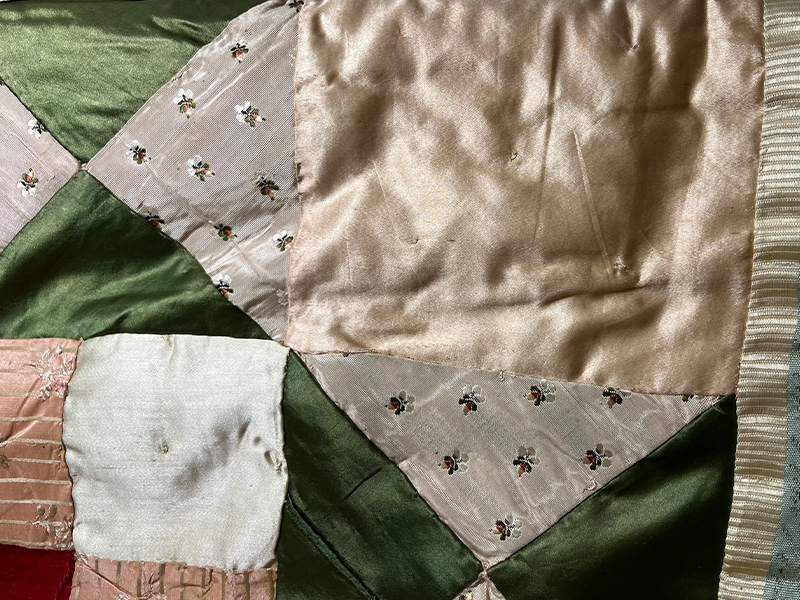Unraveling 18th-Century Textiles, Revolutionary Spaces Program Examines Quilt Made of Martha Washington’s Dresses

Panel of professors and authors to discuss eighteenth-century women’s socioeconomic status through study of quilt fabrics believed to come from America’s First Lady’s wardrobe – May 7, Old South Meeting House
For Immediate Release
Contact: Sloane Wilten
BOSTON — In an upcoming program from nonprofit Revolutionary Spaces, a panel of speakers will examine a quilt believed to be made of fabrics from Martha Washington’s dresses to explore how eighteenth-century American women’s socioeconomic status was reflected in their clothing and textiles. On May 7, Revolutionary Spaces Associate Director of Collections Lori Erickson Fidler will be joined by award-winning professors and authors Dr. Zara Anishanslin and Dr. Kimberly Alexander to present the treasured artifact from the Revolutionary Spaces collection. Part of Revolutionary Spaces’ Material Memory program series, this panel will be moderated by Martha McNamara, Director of the New England Arts and Architecture Program and Co-Director of Architecture in the Department of Art at Wellesley College.
Starting with the fabrics found in the quilt, panelists will consider how the types of textiles that were used and worn in the American colonies during the eighteenth century can hold important insight into the lives of women and the founding of our country. Made by a descendant of George and Martha Washington, the quilt was passed down within the family and sold in the 1880s to the donor who saved the Old South Meeting House, Mary Hemenway. The panelists will also explore how the quilt, and other remnants of the Revolutionary War, contributed to the nineteenth century myth-making around the origins of our country.
“Despite being one of America’s most famous eighteenth-century women, Martha Washington remains an elusive figure. She’s mostly remembered as a little old lady in a white bonnet. But Martha Washington was much more complicated, and interesting, than this popular image. Looking at the things she made, wore, bought, and used—like the fabrics used to make this cloth monument to her—give us insight into who she really was, and how important fashion was to the life and image of the first First Lady. Martha Washington’s fashion also provides a window into something else that fundamentally shaped who she was: her identity as an enslaver,” says University of Delaware Associate Professor of History and Art History and Director of the American Civilization Program, Dr. Zara Anishanslin.
Martha Washington (1731-1802) became the first First Lady of the United States when her husband George Washington began his first presidential term in 1789. During the course of their marriage, she helped to manage George’s estates and, because of his absence due to military and presidential duties, she also became the main guardian and caretaker for their large family. Martha was well-liked and known for the many social functions she hosted in the presidential and family homes. She built a positive public image in the face of war and political unrest, and ultimately represented the presidential office while George was away. Despite being remembered for upholding the many social responsibilities that would become the standard for First Ladies, Martha was also championed for her staunch loyalty to her husband — she was often documented at the frontlines during the Revolutionary War, staying in encampments to support General Washington.
“Starting with the story of this unique object, the program will use histories of costume and textiles to explore the lives of women in the colonies during the Revolutionary period. By examining artifacts used and made by women, we can better understand their roles during the early years of our country, as well as delve into the ways in which these objects were used to construct narratives about the Revolution in the following century,” says Revolutionary Spaces Associate Director of Collections, Lori Erickson Fidler.
This is Revolutionary Spaces’ third year coordinating Material Memory programs, in which a historical expert is brought in to highlight a special artifact from the collection, focus on moments in America’s complex history, and connect people through ideas.
Threads of History: Martha Washington & the Lives of Eighteenth-Century Women
A Material Memory Program
Tuesday, May 7, 2024
- Program Begins: 6:30 PM (Doors Open: 6:00 PM)
- Location: Old South Meeting House, 310 Washington St, Boston, MA 02108
- Logistics: An evening of historical presentation that will conclude with an audience Q&A. Light snacks and refreshments will be provided in the museum store located on the lower level of the Old South Meeting House prior to the start of the program. Due to the delicate nature of the quilt, food and beverage of any kind will be strictly prohibited in the Main Hall.
- Admission: Free
- More information: Visit the event webpage here.
Threads of History: Martha Washington & the Lives of Eighteenth-Century Women is free and open to the public thanks to the generous support of The Lowell Institute.
ABOUT DR. KIMBERLY ALEXANDER
Dr. Kimberly Alexander is on the faculty of the History Department at the University of New Hampshire, where she is Director of Museum Studies and Senior Lecturer. Alexander is a James Hayes Research Fellow for 2023-2024, awarded by the UNH Center for the Humanities. She has held curatorial positions at several New England museums, including the MIT Museum, Peabody Essex Museum, and Strawbery Banke. Her most recent books are Treasures Afoot: Shoe Stories from the Georgian Era (Johns Hopkins University Press, 2018), which won an Honor Award from Historic New England in 2019, and Fashioning the New England Family (Massachusetts Historical Society, 2021).
ABOUT DR. ZARA ANISHANSLIN
Dr. Zara Anishanslin is a scholar and public historian who specializes in looking at history through material culture. An Associate Professor of History and Art History and the Director of the American Civilization Program at the University of Delaware, she focuses on Early American and Atlantic World History. Her first book, Portrait of a Woman in Silk: Hidden Histories of the British Atlantic World (Yale University Press, 2016) showed how making, buying, and using goods in the 18th century British Atlantic world tied its inhabitants together while allowing for different views of the Empire. When not in the classroom or archives, Anishanslin talks history on a wide variety of podcasts and TV shows and consults on exhibitions, including the Philadelphia Museum of Art’s early American galleries and Lin-Manuel Miranda’s Hamilton: The Exhibition. Anishanslin is currently a Postdoctoral Fellow at the David Center for the American Revolution at the American Philosophical Society. Her next project, Under the King’s Nose: Ex-Pat Patriots during the American Revolution (The Belknap Press of Harvard University Press), will be published in 2025.
ABOUT LORI ERICKSON FIDLER
Lori Erickson Fidler is Associate Director of Collections for Revolutionary Spaces. She manages the object collections and archives, overseeing collections care, planning, and documentation. Before joining Revolutionary Spaces, Lori held positions as Curator and Collections Manager in addition to working as a museum collections and exhibitions consultant. She holds both a Bachelor of Arts and a Master of Science in Anthropology, with a focus on archaeology and museum studies.
ABOUT MARTHA MCNAMARA (Moderator)
Martha McNamara is an art and architectural historian who specializes in the visual and material culture of New England. McNamara is Director of the New England Arts and Architecture Program and Co-Director of Architecture in the Department of Art at Wellesley College where she teaches courses in American art and architectural history, historic preservation, the history of cities, and material culture studies. She currently serves as Board Chair of Revolutionary Spaces.
ABOUT REVOLUTIONARY SPACES
Revolutionary Spaces stewards the historic Old South Meeting House and Old State House as landmarks, museums, and gathering spaces for the open exchange of ideas and the continuing practice of democracy. Viewing history as a powerful tool for today, Revolutionary Spaces brings people together to explore the American struggle to create and sustain a free society.
ABOUT THE OLD SOUTH MEETING HOUSE
The 1729 Old South Meeting House was a Congregational church and the largest gathering place for popular politics in Revolutionary Boston. Today it is a busy museum, treasured landmark, and active center for civic dialogue and free expression.
ABOUT THE OLD STATE HOUSE
The 1713 Old State House served as the seat of government for the province of Massachusetts during the Revolutionary era. Today, it is a museum and historic site offering tours, exhibits, and public programs exploring Boston’s Revolutionary-era history.

